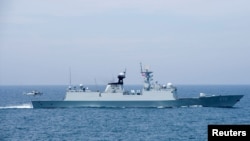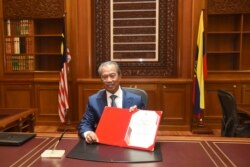Malaysia and Vietnam, militarily weaker than China, are expected to protest through diplomatic channels over a Chinese survey ship fleet that entered disputed waters this month, inviting a long but nonviolent standoff.
Both Southeast Asian countries are monitoring movement of the Chinese Haiyang Dizhi 8 fleet, which multiple news reports say passed through disputed tracts of the South China Sea last week. The same vessel spent four months in 2019 in an oil-rich tract of the sea claimed by Vietnam and blocked Vietnamese crews from exploring for oil underwater.
This time both states will probably protest diplomatically to China but do little more, analysts believe. They lack China’s overall military might. Malaysia’s prime minister, in office for less than two months, also has little foreign policy experience.
Against that muted response, China could keep its survey fleet in disputed waters and stymie the energy drilling efforts of Malaysia and Vietnam, experts believe.
“It’s just the status quo,” said Carl Thayer, emeritus professor at the University of New South Wales in Australia.
“China is doing its survey work and Malaysia’s searching for oil, and occasionally they have harassment and close calls -- diplomatic pressure behind the scenes – and then at some point weather changes or what not and China, if Malaysia doesn’t cave in, takes the vessel and brings it back,” Thayer said.
This sort of friction surfaces regularly in the broader South China Sea dispute.
China, Malaysia, Vietnam and three other governments claim all or part of the 3.5 million-square-kilometer waterway. They prize it for fisheries, shipping lanes, oil and natural gas. China has grown more powerful than the other claimants over the past 10 years by landfilling tiny islets for military installations.
Claimant states have made little headway diplomatically in settling disputes. The U.S. Navy periodically passes ships through the South China Sea as a warning to Beijing.
New PM in Malaysia
Malaysia's Prime Minister Muhyiddin Yassin, a former interior minister appointed in March, will probably take a low-key approach to Chinese presence in the sea, analysts say. His predecessor Mahathir Mohamad had publicly questioned the basis for China’s claims and warned against use of any warships.
“This new prime minister is no Mahathir,” said Oh Ei Sun, senior fellow with the Singapore Institute of International Affairs. “He is not well known for taking a harsh diplomatic or political stand.”
Expect instead low-key negotiations between Malaysia and China, which in turn will move its vessels “peacefully but deliberately” in the disputed waters, Oh said.
China resents Malaysia for filing documentation in December to the U.N. Commission on the Limits of the Continental Shelf about plans to extend its rights in the South China Sea beyond 370 kilometers from its baselines, Thayer said. China claims about 90% of the sea and cites historical usage records as support.
Malaysia began in October looking for oil and gas just outside those 370 kilometers. A British company-managed contract drillship West Capella became the “heart of the standoff” that has also attracted Chinese coast guard vessels, the U.S. think tank-operated Asia Maritime Transparency Initiative says on its website.
The survey ship came last week with about 10 escort boats and might return with 20 or 30 –an unprecedented show of force by China toward Malaysia – said a scholar doing research for the Malaysian government.
The vessel was sailing near China’s mainland east of Hong Kong as of late Sunday, according to ship tracking website Marine Traffic.
Vietnam learned from 2019
In July last year, the same Chinese energy survey ship began patrolling near Vanguard Bank 352 kilometers off the coast of southeastern Vietnam. Vietnam operates an undersea energy exploration platform near Vanguard Bank. The vessel left in October.
Vietnamese and Chinese boats rammed one another in 2014 when China allowed an oil rig into disputed waters. But when the survey vessel showed last year, China just kept Vietnam away from its oil drilling site and the standoff came down to “who blinks first”, Thayer said.
Vietnam will probably protest again this time and avoid use of force, scholars say.
In that case, Haiyang Dizhi 8’s fleet could spend two to three months in disputed waters this year by using landfilled islands for resupply, said Nguyen Thanh Trung, Center for International Studies director at the University of Social Sciences and Humanities in Ho Chi Minh City.
Vietnam hopes eventually for backup from other Southeast Asian states, he said.
“This is like the annual,” Nguyen said. “It seems to me this is the second time the survey ship is back to the South China Sea. If the Southeast Asian countries do not collaborate right now, maybe next year the survey ship will be back again and maybe they will choose another area of the South China Sea for the survey.”







